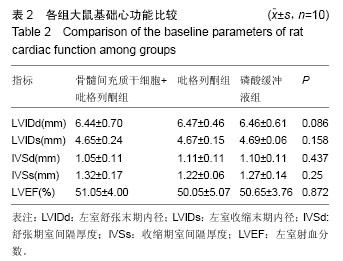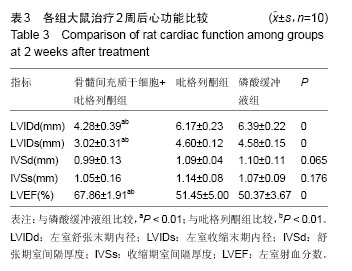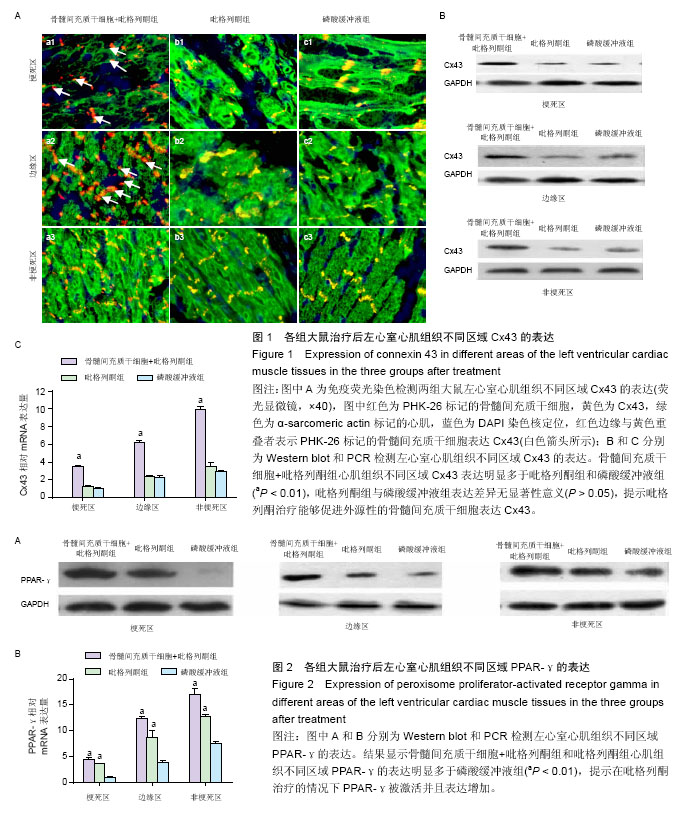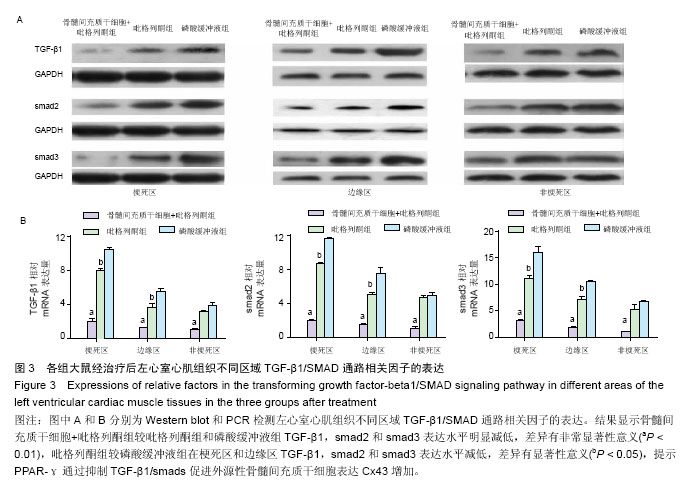| [1] Carvalho E, Verma P, Hourigan K, et al. Myocardial infarction: stem cell transplantation for cardiac regeneration. Regen Med. 2015;10(8):1025-1043.
[2] Karantalis V, Hare JM. Use of mesenchymal stem cells for therapy of cardiac disease. Circ Res. 2015;116(8): 1413-1430.
[3] Wen Z, Zheng S, Zhou C, et al. Repair mechanisms of bone marrow mesenchymal stem cells in myocardial infarction. J Cell Mol Med. 2011;15(5):1032-1043.
[4] Shinmura D, Togashi I, Miyoshi S, et al. Pretreatment of human mesenchymal stem cells with pioglitazone improved efficiency of cardiomyogenic transdifferentiation and cardiac function. Stem Cells. 2011;29(2):357-366.
[5] 伍权华,侯婧瑛,郭天柱,等.吡格列酮联合骨髓间充质干细胞移植治疗改善大鼠心肌梗死后的心功能[J].中国组织工程研究,2015,19(23): 3698-3704.
[6] Chen J, Zheng S, Huang H, et al. Mesenchymal stem cells enhanced cardiac nerve sprouting via nerve growth factor in a rat model of myocardial infarction. Curr Pharm Des. 2014;20(12):2023-2029.
[7] Wang T, Sun S, Wan Z, et al. Effects of bone marrow mesenchymal stem cells in a rat model of myocardial infarction. Resuscitation. 2012;83(11):1391-1396.
[8] Xing Y, Hou J, Guo T, et al. microRNA-378 promotes mesenchymal stem cell survival and vascularization under hypoxic-ischemic conditions in vitro. Stem Cell Res Ther. 2014;5(6):130.
[9] Zheng S, Zhou C, Weng Y, et al. Improvements of cardiac electrophysiologic stability and ventricular fibrillation threshold in rats with myocardial infarction treated with cardiac stem cells. Crit Care Med. 2011; 39(5):1082-1088.
[10] Carvalho E, Verma P, Hourigan K, et al. Myocardial infarction: stem cell transplantation for cardiac regeneration. Regen Med. 2015;10(8):1025-1043.
[11] Shen H, Wang Y, Zhang Z, et al. Mesenchymal Stem Cells for Cardiac Regenerative Therapy: Optimization of Cell Differentiation Strategy. Stem Cells Int. 2015; 2015: 524756.
[12] 王彤,黄子通.骨髓间充质干细胞和心血管疾病[J].中国急救医学,2008,28(7): 645-648.
[13] Russo V, Young S, Hamilton A, et al. Mesenchymal stem cell delivery strategies to promote cardiac regeneration following ischemic injury. Biomaterials. 2014;35(13):3956-3974.
[14] Cong XQ, Li Y, Zhao X, et al. Short-Term Effect of Autologous Bone Marrow Stem Cells to Treat Acute Myocardial Infarction: A Meta-Analysis of Randomized Controlled Clinical Trials. J Cardiovasc Transl Res. 2015;8(4):221-231.
[15] Zimmet H, Porapakkham P, Porapakkham P, et al. Short- and long-term outcomes of intracoronary and endogenously mobilized bone marrow stem cells in the treatment of ST-segment elevation myocardial infarction: a meta-analysis of randomized control trials. Eur J Heart Fail. 2012;14(1):91-105.
[16] Psaltis PJ, Spoon DB, Wong DT. Utility of mesenchymal stromal cells for myocardial infarction. Transitioning from bench to bedside. Minerva Cardioangiol. 2013;61(6):639-663.
[17] Li N, Yang YJ, Qian HY, et al. Intravenous administration of atorvastatin-pretreated mesenchymal stem cells improves cardiac performance after acute myocardial infarction: role of CXCR4. Am J Transl Res. 2015;7(6):1058-1070.
[18] Liu C, Fan Y, Zhou L, et al. Pretreatment of mesenchymal stem cells with angiotensin II enhances paracrine effects, angiogenesis, gap junction formation and therapeutic efficacy for myocardial infarction. Int J Cardiol. 2015;188:22-32.
[19] Lecarpentier Y, Claes V, Hébert JL. PPARs, Cardiovascular Metabolism, and Function: Near- or Far-from-Equilibrium Pathways. PPAR Res. 2010;2010. pii: 783273.
[20] Nagashima A, Watanabe R, Ogawa M, et al. Different roles of PPAR-γ activity on physiological and pathological alteration after myocardial ischemia. J Cardiovasc Pharmacol. 2012;60(2):158-164.
[21] Chiang MC, Cheng YC, Lin KH, et al. PPARγ regulates the mitochondrial dysfunction in human neural stem cells with tumor necrosis factor alpha. Neuroscience. 2013;229:118-129.
[22] Takada I, Kouzmenko AP, Kato S. PPAR-gamma Signaling Crosstalk in Mesenchymal Stem Cells. PPAR Res. 2010;2010. pii: 341671.
[23] Tian YQ, Li SS, Su XD, et al. Effects of pioglitazone on high-fat-diet-induced ventricular remodeling and dysfunction in rats. J Cardiovasc Pharmacol Ther. 2012;17(2):223-228.
[24] Nakamoto M, Ohya Y, Shinzato T, et al. Pioglitazone, a thiazolidinedione derivative, attenuates left ventricular hypertrophy and fibrosis in salt-sensitive hypertension. Hypertens Res. 2008;31(2):353-361.
[25] Wang H, Zhu QW, Ye P, et al. Pioglitazone attenuates myocardial ischemia-reperfusion injury via up-regulation of ERK and COX-2. Biosci Trends. 2012;6(6):325-332.
[26] Deng YL, Xiong XZ, Cheng NS. Organ fibrosis inhibited by blocking transforming growth factor-β signaling via peroxisome proliferator-activated receptor γ agonists. Hepatobiliary Pancreat Dis Int. 2012;11(5): 467-478.
[27] Fan F, Li Y, Duan X, et al. Rosiglitazone attenuates activation of human Tenon's fibroblasts induced by transforming growth factor-β1. Graefes Arch Clin Exp Ophthalmol. 2012;250(8):1213-1220.
[28] Gong K, Xing D, Li P, et al. Hypoxia induces downregulation of PPAR-γ in isolated pulmonary arterial smooth muscle cells and in rat lung via transforming growth factor-β signaling. Am J Physiol Lung Cell Mol Physiol. 2011;301(6):L899-907.
[29] Dai P, Nakagami T, Tanaka H, et al. Cx43 mediates TGF-beta signaling through competitive Smads binding to microtubules. Mol Biol Cell. 2007;18(6): 2264-2273. |
.jpg)




.jpg)
.jpg)
.jpg)